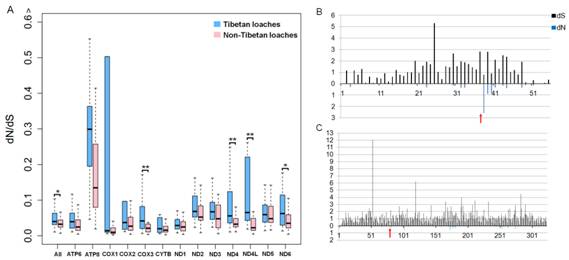
Newsroom
Mitogenomic Analyses Revealed the Origin of Tibetan Loaches and Their Adaptation to High Altitude
Numerous studies have demonstrated the role of selection in mtDNA evolution and detected signals of positive selection in mitochondrial genes in endemic taxa of the Tibetan Plateau. Tibetan loaches are the largest group of Tibetan fishes and well adapted to the Tibetan Plateau. However, understanding of the genetic mechanisms that underlie the adaptations of Tibetan loaches to their high-altitude environment from a mitogenomic perspective is lacking.
Researchers led by Prof. HE Shunping from Institute of Hydrobiology, Chinese Academy of Sciences (IHB) utilized the mitogenomes of the superfamily Cobitoidea to investigate the origin of Tibetan loaches and their adaptation to high altitude. They provided insights to the origin of Tibetan loaches and the genetic mechanisms for adaptation of fishes to high-altitudes from mitogenomic perspectives.
In this study, IHB researchers analyzed 32 complete, newly determined mitogenomes along with 64 published mitogenomes of the superfamily Cobitoidea to confirm the phylogenetic status of the genus Triplophysa within Nemacheilidae. They also dated the origin of the Triplophysa lineages, and provided a comprehensive view of the adaptive evolution of the mitogenome in Triplophysa species.
They found that first the genus Triplophysa formed a monophyletic group within Nemacheilidae. Second, the molecular dating time suggested that the lineage leading to the Tibetan loaches approximately originated in 23.5 Ma. This origin time is consistent with the period of recent major uplifts of the Tibetan Plateau in the Early Miocene. Third, Tibetan loaches accumulated more nonsynonymous mutations than non-Tibetan loaches and exhibited rapid evolution at the mitochondrial genome level. More importantly, the researchers detected two positively selected genes ATP8 and ND1 responsible for the high altitude adaptation.
This study is the first indications that the origin and evolution of this group is related to the uplift of the Tibetan Plateau, and also provided investigations to the genetic mechanisms of adaptation to the conditions on Tibetan Plateau in the Tibetan loaches from mitogenomic perspectives.
The study was published in Scientific Reports Journal with the title “Mitogenomic perspectives on the origin of Tibetan loaches and their adaptation to high altitude.” This work was supported by the Pilot projects.

Figure: Selection pressure analysis and the positive genes identified for Triplophysa fishes (Image by IHB)